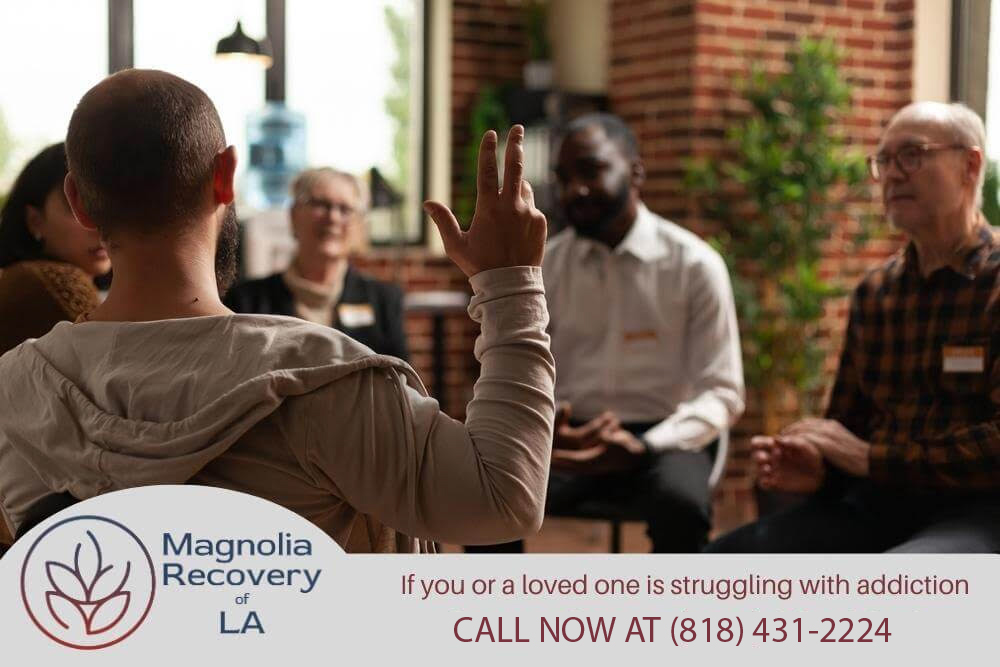Top Rated Drug Detox Program
Have you been trying to quit drinking or drugs, but the withdrawal symptoms are just too awful to tolerate? You may need to attend a medically supervised detox program. Magnolia Recover is here for you; we run one of the best medical detox programs in the state. Keep reading to discover how you can withdraw from a physical dependency on drugs and alcohol with ease and minimal discomfort in our detox program.
What Is Detox Like?
You’ll be supervised 24/7 in our residential facility when participating in our medical detox program. The atmosphere is the opposite of a clinical hospital setting; you’ll be comfortable wearing your clothes and enjoying our amenities. As for what detox is like, that varies based on pre-determined factors like
- Your age
- Your history of substance use
- The amount of time using the substance
- Your metabolism and other genetic factors
- Underlying health issues
- Method of drug use like snorting or IV
These factors will be assessed when you arrive at the residential facility and undergo a biopsychosocial evaluation. If you have ever experienced withdrawal symptoms due to being unable to access drugs or alcohol, you may know how unpleasant they can be. You will be protected from the worst of these symptoms when you undergo a supervised medical detox at Magnolia. Our doctors and specialists will prescribe medication to ease the pain of said symptoms. You’ll have access to emotional support around the clock as you travel through detoxification. You must never attempt to detox from drug and alcohol use alone, as withdrawal symptoms can quickly become life-threatening.
What to Expect During Drug Detox?
The detoxification process from drugs and alcohol follows a similar timeline regardless of the substance and can be generalized into the following timeframe.
- 6 to 8 hours after your last dose. Your central nervous system begins to send you unpleasant messages requiring more of the substance you depend on.
- 12 to 24 hours after your last dose. By now, your central nervous system sends you periodic messages that it requires drugs/alcohol. This is because, over time, your nervous system adapts to function with drugs/alcohol present. The process of withdrawal is your nervous system learning to work without it.
- 24-48 hours after your last dose. Depending on the substance, this will be the most unpleasant period for most people.
- 48-72 hours after your last dose. Depending on what you’re withdrawing from, this period is when symptoms can become life-threatening, and that is why it’s critical to detox in a supervised facility.
- 72 hours and beyond. In most cases, the physical symptoms of withdrawal will begin to fade. The emotional aspects of withdrawal can persist for weeks or even months, so inpatient treatment is recommended after a medical detox.
Symptoms of Detox by Drug Type
Each drug, including alcohol, has similar withdrawal symptoms, but the severity and length of those symptoms vary widely from drug to drug.
Benzos
Benzos, short for benzodiazepines, are in the top three “worst substances to withdraw from” category. Singer and songwriter Stevie Nicks are open about how awful the process of withdrawing from Klonopin was for her, spending 47 days in the hospital with severe symptoms after eight years of continuous use. Benzodiazepines are meant for short-term use only, a maximum of a few weeks. The following symptoms characterize benzodiazepine withdrawal.
- Insomnia
- Mast cell activation
- Panic attacks
- Severe anxiety
- Hand tremors
- Shaking
- Sweating
- Nausea
- Vomiting
- Confusion
- Cognitive difficulty and memory problems
- Muscle pain
- Headache
- Convulsions
- Suicidal ideation
Detoxing from benzos like Xanax or Valium may result in seizures, which are considered life-threatening. Anyone experiencing this is deemed to be having a medical emergency, which is why it is so critical to have medical supervision.
Opioids (Heroin)
Another contender in the top 3 worst drugs to withdraw from is opioids. Factors like using a more significant amount of opioids for over six months increase the severity of withdrawal symptoms compared to slow-acting opioids. Your medical team will assess you for the following signs of opioid withdrawal syndrome.
- Resting pulse rate
- Gastrointestinal upset
- Sweating
- Tremors
- Restlessness
- Yawning
- Pupil size
- Anxiety or irritability
- Bone or joint aches
- Goose pimples, aka gooseflesh skin
- Runny nose and tearing of the eyes
If these signs are pronounced, your medical team will begin to administer medicine to counteract the symptoms of opioid withdrawal syndrome. You can expect similar symptoms when detoxing from opioids, like
- Extreme anxiety
- Nausea and vomiting
- Muscle aches
- Fever
- Diarrhea
- Sweating
As with benzos, the most significant risk to your health is seizures, which can be fatal.
Stimulants (Cocaine, Meth, etc)
Methamphetamine addiction carries its unique horrors, including permanent brain damage, psychosis, and reduced serotonin production. This means a long-term meth user may not feel happiness without meth in their system. The psychosis induces skin picking, which covers their bodies with scabs and sores. Another unpleasant aspect of meth use is tooth decay, called “meth mouth.
Withdrawal from stimulants like meth, speed, and cocaine doesn’t present the same physical risks as drugs like opioids or benzos. Still, that knowledge is of little comfort to those experiencing withdrawal symptoms. You may experience these symptoms when detoxing from stimulant addiction.
- Fatigue
- Severe anxiety
- Insomnia, then followed by hypersomnia
- Lack of energy
- Weight gain
- Chills
- Dysphoria
- Anhedonia
Although the physical symptoms of stimulant addiction ease within about a week, some people experience protracted psychological symptoms for weeks and months that include
- Depression
- Mood swings
- Drug cravings
- Loss of ability to feel joy
- Psychosis
- Suicidal thoughts
Bath Salts
Even though this category of drugs is called bath salts, they are not the crystals you purchase to add to your bathwater. They got that name from being disguised as legitimate bath salts to transport and sell. The drug called bath salts is cathinone, a substance similar to amphetamines. The detox for bath salts is similar to the detox for meth, cocaine, and speed.
Marijuana
You may be surprised to learn that there are withdrawal symptoms when you stop smoking weed, especially when use is chronic and long-term. You may experience symptoms like
- Headaches
- Low mood
- Anxiety
- Decreased appetite
- Excessive sweating
- Poor sleep
- Stomach pains
- Fever
- Tremors
DXM/Cough Syrup
Those that use dextromethorphan to get high may find themselves experiencing withdrawal symptoms when they stop using the drug. You may experience things like
- Cold sweats
- Diarrhea
- Vomiting
- Bone and muscle aches
Ecstasy/Molly/MDMA
MDMA provides a high with both stimulant and hallucinogenic properties, affecting our serotonin and dopamine neurotransmitters. When people take MDMA, they get a big rush of pleasure from those neurotransmitters, followed by a crash as the production of those feel-good messengers slows. This crash can last for a week and includes symptoms such as
- Fatigue
- Loss of appetite
- Depression
- Trouble concentrating
- Depression
- Lethargy
- Dissatisfaction with life
While not considered physically dangerous to withdraw from, the emotional and psychological aspects of quitting long-term MDMA use can be distressing for the person experiencing them.
Fentanyl
Fentanyl is a powerful synthetic opioid and shares the same characteristics with other opioids like heroin, oxycodone, and morphine, such as
- Extreme anxiety
- Nausea and vomiting
- Muscle aches
- Fever
- Diarrhea
- Sweating
You should never attempt to detox from Fentanyl alone; like any other opioid, the complications can be fatal if not treated.
Hallucinogens
Hallucinogens are a broad umbrella for LSD, PCP, magic mushrooms, and ketamine. Not all these drugs create a physical dependency, but PCP and ketamine do. PCP and ketamine are classified as dissociative hallucinogens, while mushrooms and LSD are classic hallucinogens. Symptoms of withdrawal from PCP and ketamine include the following.
- Stiff muscles
- Depressed breathing
- Convulsions
- Rapid heart rate
- Extreme changes in body temperature
- Cravings
- Headaches
- Sweating
- Seizures
- Flashbacks
Oxycodone
Oxycodone is a powerful synthetic opioid painkiller for treating severe pain after surgeries, accidents, or illnesses. If you’ve been taking oxycodone for a couple of weeks, you should be able to stop without withdrawal symptoms. Suppose you’ve been taking oxycodone for more than that. In that case, however, you’ll need to undergo a supervised medical detox for your safety. Withdrawing from oxycodone is identical to withdrawing from any other opioid, including heroin.
Prescription Drugs
Unfortunately, the same drugs active in prescriptions are those people buy on the illicit drug market. This means that the help you need to stop taking your prescription drugs is the same that someone taking illegal drugs would need, and that is a medically supervised detox. Even if you are using medications prescribed by your doctor, your body will go through the same process when getting the drug out of your system.
Acute Detox
Suppose you have been drinking or using drugs for a significant amount of time, perhaps years. In that case, you must undergo acute detox. “Acute” means critical or life-threatening in medical language and indicates a severe addiction. Someone who undergoes acute detox will require 24/7 monitoring of their health to prevent withdrawal symptoms like seizures and respiratory problems from becoming fatal. People attempting to recover from alcohol, opioid, and benzodiazepine use generally require acute detox.
Sub Acute Detox
Sub-acute detox may be an option for someone experiencing a less severe addiction. This type of detox can be done in an outpatient setting, with checkups done by a primary doctor, urgent care center, or rehab facility. This is a good option for those using less harmful substances with a low seizure risk. Although the process may take weeks or months, sub-acute detox allows the participant to return home at night.
Why Choose Magnolia Recovery for Drug Detox
Magnolia Recovery is experienced in guiding clients through the detox process with a minimum amount of discomfort. Our staff feels privileged to help you as you progress toward sobriety, and we genuinely care about your success. Our treatment facility is bright, comfortable, and beautifully appointed. You will never feel like you’re in a hospital or that you’re just a number when participating in Magnolia Recovery treatment. We accept most major insurers and welcome couples who are looking to make changes in their lives. We pride ourselves on offering fantastic amenities, like a pool, smart TV, nutritious meals and snacks, and organized day trips to parks, museums, and beaches. You will never regret attending detox at Magnolia Recovery; instead, you’ll remember your stay as the beginning of your new life, free from the grasp of drugs and alcohol. You must take the first step on your road to recovery; call us right now at (818) 431-2224 to begin that journey.


